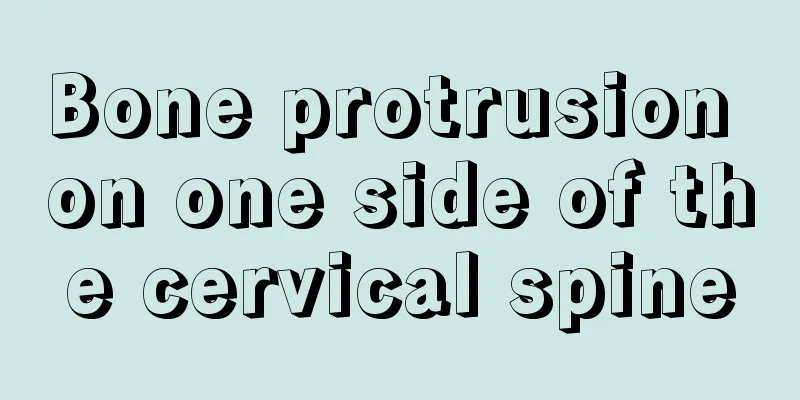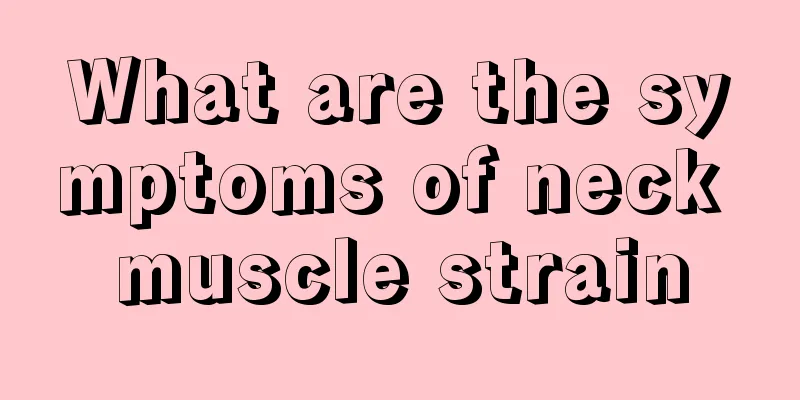Bone protrusion on one side of the cervical spine

|
The protrusion of the cervical bones behind the neck is mostly caused by strain of the soft tissues of the neck or imbalance of the mechanical balance of the cervical spine. Whether it is cervical spondylosis needs to be confirmed by going to the hospital for an X-ray examination. However, due to the existence of mobile phones and computers, there are more and more people who are addicted to their phones, which leads to an increasing number of cervical spondylosis diseases. This article introduces the causes of cervical spondylosis. Let’s take a look at it. 1. Degeneration of the cervical spine Degenerative changes of the cervical spine are the main cause of cervical spondylosis, among which the degeneration of the intervertebral disc is particularly important and is the primary factor in the degeneration of the cervical spine structures. From this, a series of pathological anatomical and pathophysiological changes of cervical spondylosis have evolved. ① Degeneration of the intervertebral disc; ② The appearance of the ligament-disc space and hematoma formation; ③ The formation of bone spurs on the edge of the vertebral body; ④ Degeneration of other parts of the cervical spine; ⑤ Reduction in the sagittal diameter and volume of the spinal canal. 2. Developmental cervical spinal stenosis In recent years, it has been confirmed that the inner diameter of the cervical spinal canal, especially the sagittal diameter, is closely related not only to the occurrence and development of cervical spondylosis, but also to the diagnosis, treatment, selection of surgical methods and prognosis of cervical spondylosis. Some people have severe cervical degeneration and obvious osteophyte hyperplasia, but they do not develop the disease. The main reason is that the sagittal diameter of the cervical spinal canal is wide and there is a large compensatory space in the spinal canal. For some patients, cervical degeneration is not very serious, but the symptoms appear early and are more severe. 3. Chronic strain Chronic strain refers to various excessive activities that exceed the maximum range of normal physiological activities or the local tolerance value. Because it is different from obvious trauma or accidents in life and work, it is easy to be ignored, but it has a direct relationship with the occurrence, development, treatment and prognosis of cervical spondylosis. The generation and cause of this kind of strain mainly come from the following three situations: (1) Improper sleeping position: An improper sleeping position lasts for a long time and cannot be adjusted in time when the brain is in a resting state, which will inevitably cause imbalance of the paravertebral muscles, ligaments and joints. (2) Improper working posture. A large amount of statistical data shows that the incidence of cervical spondylosis is particularly high among people who do not have a large workload or high intensity work, but are sitting or working with their heads down. These people include houseworkers, embroiderers, office workers, typists, assemblers on instrument assembly lines, etc. (3) Inappropriate physical exercise Normal physical exercise is good for health, but activities or exercises that exceed the neck's tolerance, such as handstands or somersaults with the head and neck as the weight-bearing support points, can increase the load on the cervical spine, especially without proper guidance. 4. Congenital malformation of the cervical spine The clinical symptoms of cervical spondylosis are relatively complex. The main symptoms include neck and back pain, upper limb weakness, numbness of fingers, lower limb weakness, difficulty walking, dizziness, nausea, vomiting, and even blurred vision, tachycardia and difficulty swallowing. The clinical symptoms of cervical spondylosis are related to the site of the lesion, the degree of tissue involvement and individual differences. 1. Cervical spondylotic radiculopathy (1) It has typical radicular symptoms (numbness, pain), and the range is consistent with the area innervated by the cervical spinal nerves. (2) Positive head pressure test or brachial plexus traction test. (3) The imaging findings are consistent with the clinical manifestations. (4) Pain point blocking has no significant effect. (5) Diseases other than the cervical spine, such as thoracic outlet syndrome, carpal tunnel syndrome, cubital tunnel syndrome, and frozen shoulder, which are the main causes of upper limb pain. 2. Cervical spondylotic myelopathy (1) Clinical manifestations of cervical spinal cord damage. (2) X-rays show bone hyperplasia at the posterior edge of the vertebral body and spinal canal stenosis. Imaging confirmed the presence of spinal cord compression. (3) Excludes amyotrophic lateral sclerosis, spinal cord tumors, spinal cord injury, multiple neuritis, etc. 3. Vertebral artery type cervical spondylosis (1) A history of cataplexy. Accompanied by cervical vertigo. (2) The neck rotation test is positive. (3) X-rays show segmental instability or bone hyperplasia of the axis joint. (4) Often accompanied by sympathetic nervous system symptoms. (5) Exclude vertigo caused by eyes or ears. (6) Except for the insufficiency of the basilar artery caused by compression of the vertebral artery segment I (the segment of the vertebral artery before entering the transverse foramen of C6) and the vertebral artery segment III (the segment of the vertebral artery before leaving the cervical vertebrae and entering the skull). (7) Vertebral arteriography or digital subtraction vertebral arteriography (DSA) is required before surgery. 4. Sympathetic cervical spondylosis The clinical manifestations include a series of sympathetic nervous system symptoms such as dizziness, blurred vision, tinnitus, numbness of hands, tachycardia, precordial pain, etc. X-rays show instability or degeneration of the cervical spine. Vertebral arteriography was negative. 5. Esophageal compression type cervical spondylosis Bird-beak-like hyperplasia in front of the cervical vertebrae compresses the esophagus and causes dysphagia (confirmed by esophageal barium examination), etc. 6. Cervical spondylosis Cervical spondylosis, also known as local cervical spondylosis, refers to pain in the head, shoulders, neck, and arms and corresponding tenderness points. There are no obvious degenerative changes such as intervertebral disc stenosis on X-rays, but there may be changes in the physiological curve of the cervical spine, intervertebral instability, and mild bone hyperplasia. When performing health examinations or comparative research radiographs on the cervical spine of normal people, various abnormalities are often found in the cervical spine segments, of which obvious bone deformities account for about 5%. 1. Swallowing disorders There is a feeling of obstruction when swallowing and a foreign body sensation in the esophagus. A few people experience symptoms such as nausea, vomiting, hoarseness, dry cough, and chest tightness. This is due to the direct compression of the posterior wall of the esophagus by the front edge of the cervical spine, causing esophageal stenosis. It may also be caused by the rapid formation of bone spurs, which causes irritation of the soft tissue around the esophagus. 2. Visual impairment Symptoms include decreased vision, eye pain, photophobia, tearing, unequal pupil sizes, and even a narrowing of the visual field and a sharp decrease in vision. Some patients may even go blind. This is related to the ischemic lesions in the visual center of the occipital lobe of the brain caused by autonomic nervous system disorders and insufficient blood supply to the vertebral-basilar artery due to cervical spondylosis. 3. Cervical heart syndrome Symptoms include precordial pain, chest tightness, arrhythmia (such as premature beats) and ST segment changes on the electrocardiogram, and it is easily misdiagnosed as coronary heart disease. This is caused by the stimulation and compression of the cervical nerve roots by cervical bone spurs. 4. Hypertension and cervical spondylosis It can cause high or low blood pressure, among which high blood pressure is more common, which is called "cervical hypertension". Since cervical spondylosis and hypertension are both common diseases among middle-aged and elderly people, the two often coexist. 5. Chest pain It presents with slow onset of persistent unilateral pectoralis major and breast pain, with pectoralis major tenderness on examination. This is related to the compression of the C6 and C7 nerve roots by cervical bone spurs. 6. Paralysis of lower limbs The early symptoms are numbness, pain, and lameness in the lower limbs. Some patients feel like they are walking on cotton when walking. Some patients may also have bowel and urination disorders, such as frequent urination, urgency, difficulty urinating, or incontinence. This is because the lateral vertebral bundle is stimulated or compressed by the cervical bone spurs, resulting in movement and sensory disorders in the lower limbs. 7. Cataplexy People often collapse suddenly when standing or walking due to a sudden turn of the head, which causes the body to lose support. They wake up quickly after falling to the ground, without any disturbance of consciousness or sequelae. Such patients may experience symptoms of autonomic dysfunction such as dizziness, nausea, vomiting, and sweating. This is because the proliferative changes of the cervical vertebrae compress the vertebral artery, causing obstruction of blood supply to the basilar artery, resulting in temporary cerebral ischemia. |
<<: One-sided optic nerve damage
>>: There is a stabbing pain on one side of my head
Recommend
Can watermelon and duck meat be eaten together
There are some aspects of mutual promotion and re...
Is Huaxi beef rice noodles high in calories?
Beef rice noodles are very popular among young pe...
What are the sequelae of ovarian tumor surgery
We may still not know much about ovarian tumors. ...
What to do if you have severe allergies? Eat these foods if you have allergies
Skin allergies are very common and are not a seri...
What's wrong with the peeling of the corners of my eyes like ringworm?
The eyes are a very important part of our body. O...
What can I eat to make yellow hair black? Finding the reason is the most important thing
Many people suffer from yellowing hair, but the r...
What methods should be used to eliminate constipation?
The occurrence of constipation actually has a lot...
Can children's cough and phlegm patches be taken orally? What is the main method of use?
For most parents, feeding children medicine is th...
How to repair scars after skin burns
People always get skin burns due to carelessness....
How long can a person with polycystic kidney disease live is actually related to these 5 factors
Polycystic kidney disease is a relatively common ...
Washing your hair like this will make it dirty! Shocked
When washing your hair normally, do you apply sha...
How to deal with a wrist cut
In our daily life, we often come into contact wit...
What is the relationship between the five internal organs and beauty
People's lives are very busy nowadays. Some p...
MRI Screening for Prostate Cancer
Prostate cancer is one of the most common maligna...
Can tongue cancer be cured
Tongue cancer is treatable, but this depends on m...









